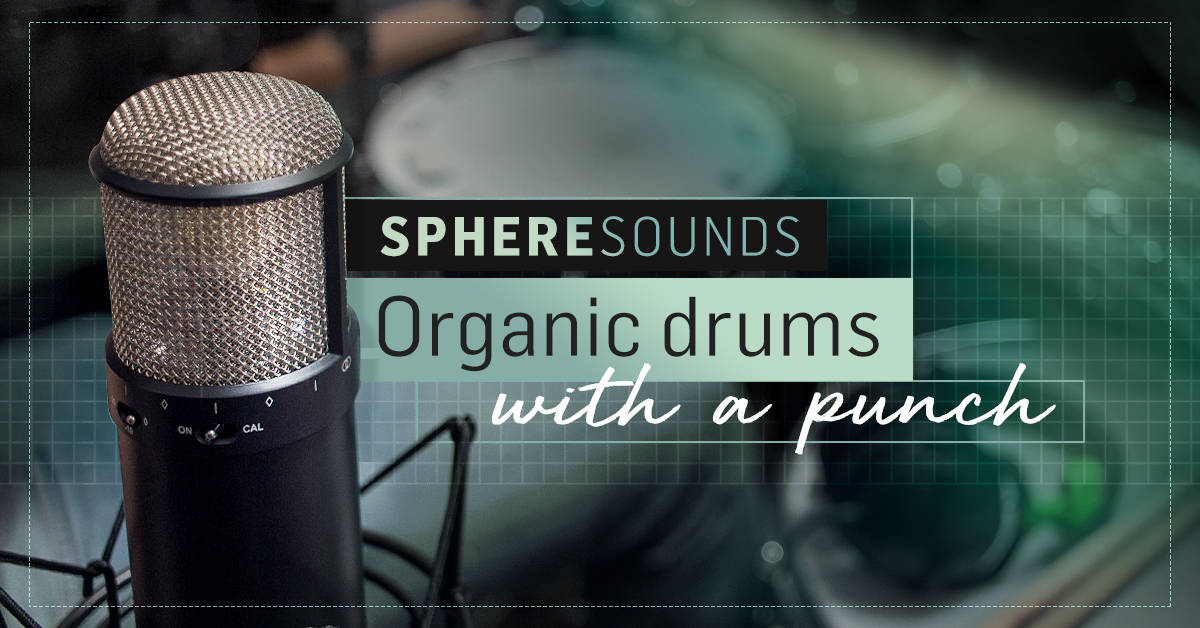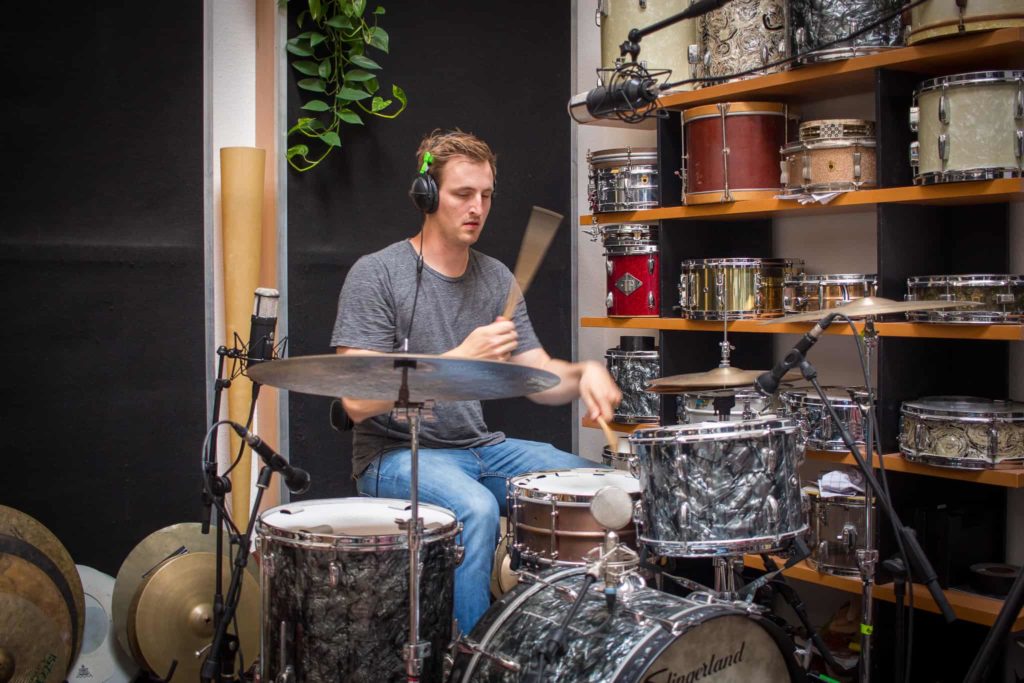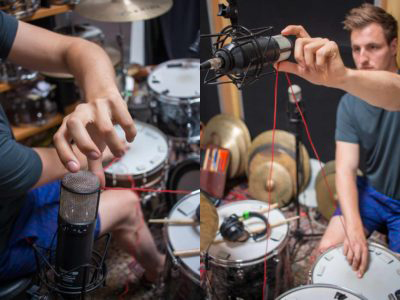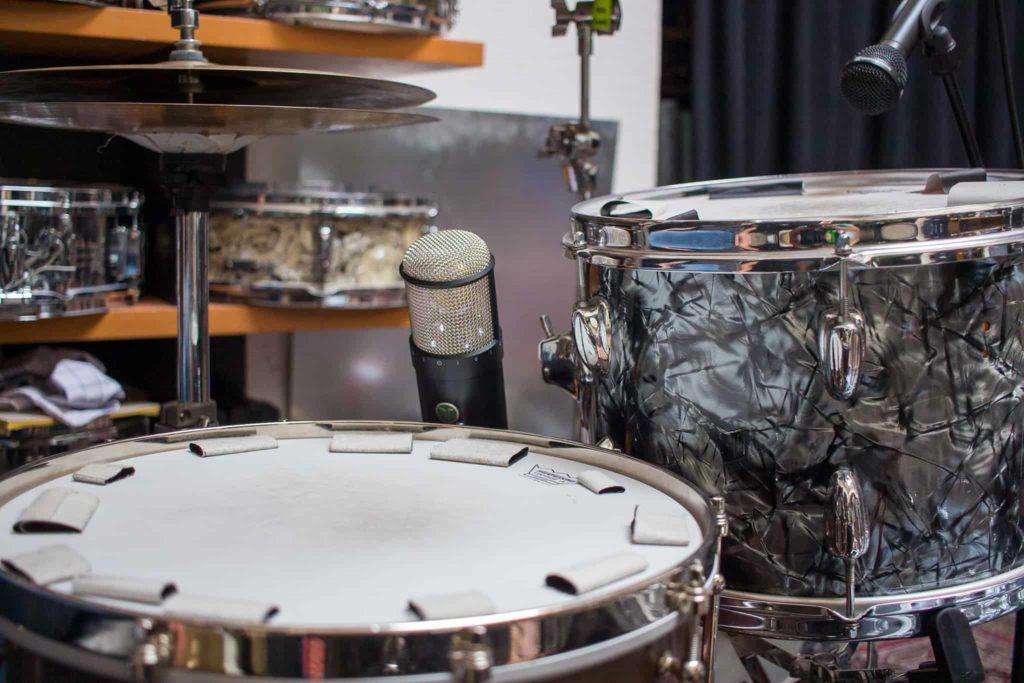Product News
2020/04/02
Explore the Sphere L22 on Drums | Sphere Sounds

Recording drums is challenging, and for rock, pop, and urban genres, great sounding drums often make or break the song. So it's an area where much attention to detail is needed. Large-diaphragm condensers are often used to capture the drum overheads, but they can also work really well on the individual drums. We teamed up with drummer Alex Höffken (Alice Merton, Namika, Balbina) in his cozy Berlin studio to record several punchy drum examples with the Sphere L22. So let's explore the Sphere L22 on drums and find out what mic models are best suited for the job.
One of the many benefits of the Sphere L22 is that it allows you to try out mic models that you'd never dare to use in real life. Even if you are the lucky owner of a vintage AKG C12 ($13k - $20k on the used market), I'd argue that you would probably hesitate to put it up close on a snare drum. The risk of an accidental stick hit from the drummer would be simply too high. Conversely, using ribbons on kick drums, in particular, can be risky due to the high-energy wind blasts that can tear apart the fragile ribbon.
Sphere 1.4 adds classic drum mics
From the beginning, our Sphere collection has included several mic models commonly used for drums, such as the DN-57 or the RB-4038. But the recent Sphere 1.4 update adding a whopping ten new models has brought us several classic choices for rock and pop drums. The DN-12 models, for example, love to be used for kick drums, while the DN-421s ooze character for snare drums. The LD-017T, commissioned by our friends at Soyuz Microphones, adds a beautiful shimmer to cymbals without ever sounding harsh. Find out more about the 1.4 update here.
The Setup
For this session, Alex set up a simple four-piece drum kit. The drums are a fantastic sounding 1970s Slingerland Sound King shell kit. Alex combined it with a more modern AK Drums Copper Standard snare drum and a basic cymbal set. The result is a well-rounded, organic-sounding kit that lends itself towards a natural, but punchy recording.
One of the many benefits of the Sphere L22 is that it allows you to try out mic models that you'd never dare to use in real life. Even if you are the lucky owner of a vintage AKG C12 ($13k - $20k on the used market), I'd argue that you would probably hesitate to put it up close on a snare drum. The risk of an accidental stick hit from the drummer would be simply too high. Conversely, using ribbons on kick drums, in particular, can be risky due to the high-energy wind blasts that can tear apart the fragile ribbon.
Sphere 1.4 adds classic drum mics
From the beginning, our Sphere collection has included several mic models commonly used for drums, such as the DN-57 or the RB-4038. But the recent Sphere 1.4 update adding a whopping ten new models has brought us several classic choices for rock and pop drums. The DN-12 models, for example, love to be used for kick drums, while the DN-421s ooze character for snare drums. The LD-017T, commissioned by our friends at Soyuz Microphones, adds a beautiful shimmer to cymbals without ever sounding harsh. Find out more about the 1.4 update here.
The Setup
For this session, Alex set up a simple four-piece drum kit. The drums are a fantastic sounding 1970s Slingerland Sound King shell kit. Alex combined it with a more modern AK Drums Copper Standard snare drum and a basic cymbal set. The result is a well-rounded, organic-sounding kit that lends itself towards a natural, but punchy recording.
Drums:
- 1970s Slingerland Sound King
- 22” x 14” kick
- 13” x 9” rack tom
- 16” x 16” floor tom
- 14” x 6.5” AK Drums Copper Standard Snare
Cymbals:
- 16” Masterwork Jazz Master hi-hat
- 20” Istanbul Agop Traditional Thin Crash
- 22” Istanbul Agop Signature Ride

We used a total of four Sphere L22 microphones on the session: A pair of mics for the drum overheads, and one mic each for the kick and the snare. We added additional microphones for the toms and underneath the snare and inside the kick drum. However, these signals were not used for the examples in this blog post. We exclusively used Universal Audio Apollo preamps without additional Unison plug-ins to record these examples. The -20 dB pad was engaged on the Sphere L22s for kick and snare.
Overheads
Let's have a listen to the overheads first, so we get an idea of what the full drum kit sounds like. Instead of a traditional spaced or coincident pair of mics, Alex is a big fan of a slightly modified "Recorderman" setup. You can find out more about this technique below, but the fundamental concept is that the kick and snare drums are positioned in the center of the stereo image. Here is a short video showing the setup and showcasing several mic models from our included mic collection.
Overheads
Let's have a listen to the overheads first, so we get an idea of what the full drum kit sounds like. Instead of a traditional spaced or coincident pair of mics, Alex is a big fan of a slightly modified "Recorderman" setup. You can find out more about this technique below, but the fundamental concept is that the kick and snare drums are positioned in the center of the stereo image. Here is a short video showing the setup and showcasing several mic models from our included mic collection.
No spot mics were included in these examples, and it is quite remarkable how well the overhead setup captures the full kit. This is particularly true when using the RB-4038 based on an iconic British ribbon mic. Here, the mics extend all the way down to the fundamental frequencies of the drums. If two microphones are all you have for a drum recording, this is the way to go.
Download the session and explore our microphone models yourself
Download the session and explore our microphone models yourself
Tip:
Experiment with different polar patterns for your overheads, regardless of the stereo technique. Unlike traditional microphones, Sphere gives you the full range of pick-up patterns opening the door to experimentation. How about going super-cardioid or even figure-8? As you focus the pattern more, kick and snare become more centered, but you might also put too much emphasis on a particular part of the drum kit. Going from cardioid to sub-cardioid or even completely omni gives you a very different stereo image with much more ambience. Have a listen to some additional examples below. It's great to have options, isn't it?
Experiment with different polar patterns for your overheads, regardless of the stereo technique. Unlike traditional microphones, Sphere gives you the full range of pick-up patterns opening the door to experimentation. How about going super-cardioid or even figure-8? As you focus the pattern more, kick and snare become more centered, but you might also put too much emphasis on a particular part of the drum kit. Going from cardioid to sub-cardioid or even completely omni gives you a very different stereo image with much more ambience. Have a listen to some additional examples below. It's great to have options, isn't it?
Recorderman explained
There are many different techniques to capture a drum set, and there are no hard and fast rules. As always, if it sounds good to your ears, it is good.
Broadly speaking, drum overhead techniques can be characterized into two categories: Those that aim at capturing mostly the cymbals relying on the spot mics to fill in the blanks. And those that attempt to render the full drum kit where the spot mics are still needed for additional punch and immediacy. The Recorderman technique falls into the second category, but it was not designed to work without spot mics. Most commonly, engineers will place some kind of stereo array (i.e., a pair of mics) over the drum kit. This stereo array could be a spaced pair, a coincident pair, or something in between, such as an ORTF setup.
While these techniques can, in fact, produce an accurate image and work well in the mix, they often do not place the snare drum in the center of the stereo image. The Recorderman technique, invented by Mixerman and Eric Greedy, was designed to lock both the kick and snare at dead center. After much finessing, the two ended up with one mic more or less over the snare and the other toward the right side of the drummer near the floor tom. This technique is somewhat similar to the Glyn Johns technique, but there are some distinct differences.
What's important when trying out this technique is making sure that both microphones are equidistant from both drums. Alex uses a string to set up a triangle: He clamps down one end in the center of the kick drum with the kick drum beater and secures the other end in the middle of the snare drum. Now he can pinch the length of the string so that he reaches the mic over the drums. With that position locked down, the second mic over his shoulder needs to be moved until he can reach it with the same length of the string.

The Recorderman technique is Alex's default setup for recording drums these days because he finds it really easy to get a great sound once it's all set up. He particularly likes the solid center image of the snare and how well both toms get picked up, especially when using the 4038 ribbons. With a little bit of compression, the drums are perfectly integrated it the mix. Often times you just need to add the kick drum mic for an excellent yet vibey sounding 3-mic setup.
Kick Drum
Moving on to the spot mics, let's find out how the Sphere L22 fares on the kick drum. Large-diaphragm condensers (LDC) work very well outside of the drum, typically a few inches from the resonant head. We also set up a Beyerdynamic M88 inside of the bass drum, but it was not used in the following examples. The video below starts with the overheads as described above, but we're then adding (and later isolating) the kick drum signal.
Kick Drum
Moving on to the spot mics, let's find out how the Sphere L22 fares on the kick drum. Large-diaphragm condensers (LDC) work very well outside of the drum, typically a few inches from the resonant head. We also set up a Beyerdynamic M88 inside of the bass drum, but it was not used in the following examples. The video below starts with the overheads as described above, but we're then adding (and later isolating) the kick drum signal.
Here, The DN-421 and DN-12 models, in particular, give you a punchy low-end that adds just the right "oomph" to the overall sound. Once again, the RB-4038 captures an incredible amount of low frequencies, but it actually becomes a little overbearing in the subs. Dialing back the proximity control or adding a high-pass filter in the Sphere plug-in can quickly address this issue. Large-diaphragm condensers typically capture a more natural and open representation of the kick drum. This can be a great choice when combined with an additional dynamic microphone inside the drum.
Download the session and explore our microphone models yourself
Snare Drum
Finally, let's explore some of the options for the snare drum. Using an LDC on the snare is not that common, but the Sphere L22 is perfectly equipped to be used up close thanks to its built-in pad. We advise starting with the -10 dB or -20 dB pad engaged, depending on how hard the drummer plays. Hear how the mic models completely transform the sound in the following video:
Download the session and explore our microphone models yourself
Snare Drum
Finally, let's explore some of the options for the snare drum. Using an LDC on the snare is not that common, but the Sphere L22 is perfectly equipped to be used up close thanks to its built-in pad. We advise starting with the -10 dB or -20 dB pad engaged, depending on how hard the drummer plays. Hear how the mic models completely transform the sound in the following video:
Each microphone model affects how the snare drum sounds and puts different aspects in the foreground. Even the various versions of the 421 have their own unique character. The dynamic models such as the DN-57 and the DN-421s have that typical punch and bite of moving-coil microphones. The RB-77DX, based on a historic RCA ribbon mic, is quite dark but would be an excellent choice for a rootsy R&B record. Using an LDC, such as the Soyuz 017 tube condenser, once again gives you a more open and airy sound.
Tip:
All of the examples in the Snare video were recorded with the Sphere mic set to a cardioid pattern. But it's worth experimenting with the polar pattern, especially if hi-hat or cymbal bleed is an issue. If you've found a snare drum model you like, switch the plug-in to dual-mode, and engage Off-Axis Correction. In a nutshell, OAC is a unique DSP process that renders a more consistent off-axis response across frequency. In our example, it allows you to freely adjust the polar pattern while retaining the sonic character of the chosen mic model.
Download the session and explore our microphone models yourself
Tip:
All of the examples in the Snare video were recorded with the Sphere mic set to a cardioid pattern. But it's worth experimenting with the polar pattern, especially if hi-hat or cymbal bleed is an issue. If you've found a snare drum model you like, switch the plug-in to dual-mode, and engage Off-Axis Correction. In a nutshell, OAC is a unique DSP process that renders a more consistent off-axis response across frequency. In our example, it allows you to freely adjust the polar pattern while retaining the sonic character of the chosen mic model.
Download the session and explore our microphone models yourself

Explore the L22 on Drums for yourself
Getting a standout drum sound is critical for many, if not all, genres. Sphere provides an incredible range of options to achieve unique drum sounds. From bright and airy to dark and rich - our included collection covers all bases. Plus, you can now use microphones that you'd never dare to put on drums in the past.
Sphere's more advanced features, such as OAC or the proximity control, can further help you get the best results possible in challenging conditions. OAC is extremely useful to reduce unwanted bleed from other drums or to avoid boxiness (more on that in a future blog). The proximity control quickly remedies overbearing low-end caused by the proximity effect of directional mics. Now it's up to you to explore the Sphere L22 on drums further. Download the plug-in and the demo tracks used in the audio and video examples now.
Getting a standout drum sound is critical for many, if not all, genres. Sphere provides an incredible range of options to achieve unique drum sounds. From bright and airy to dark and rich - our included collection covers all bases. Plus, you can now use microphones that you'd never dare to put on drums in the past.
Sphere's more advanced features, such as OAC or the proximity control, can further help you get the best results possible in challenging conditions. OAC is extremely useful to reduce unwanted bleed from other drums or to avoid boxiness (more on that in a future blog). The proximity control quickly remedies overbearing low-end caused by the proximity effect of directional mics. Now it's up to you to explore the Sphere L22 on drums further. Download the plug-in and the demo tracks used in the audio and video examples now.
